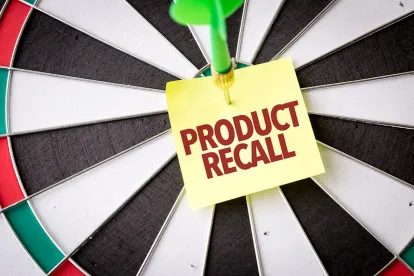OVERVIEW
The US Food and Drug Administration (FDA) published its Initiation of Voluntary Recalls Under 21 CFR Part 7, Subpart C: Guidance for Industry and FDA Staff (final guidance) on March 4, 2022. The final guidance describes how firms should develop and implement necessary recall plans and procedures that include training, planning and recordkeeping to effectively plan, prepare and initiate a voluntary recall in order to adequately protect the public from a product potentially violative of the Federal Food, Drug, and Cosmetic (FD&C) Act. The final guidance makes minor changes to an April 2019 draft version of the same title (draft guidance) and reflects the agency’s ongoing commitment to work closely with regulated firms to ensure that products in violation of the FD&C Act—or other laws enforced by FDA—are quickly taken off the market to protect public health.
Comments on the final guidance (Docket No. FDA-2018-D-2074) can be submitted at any time.
IN DEPTH
The final guidance clarifies the agency’s recommendations regarding how regulated firms in a product distribution chain should prepare to facilitate timely initiation of a voluntary recall, respond to an indication that there may be a problem with a distributed product, and initiate a voluntary recall. The guidance applies to voluntary recalls of products subject to FDA’s jurisdiction, including food, drugs and devices intended for human or animal use; cosmetics and biological products intended for human use; tobacco products intended for human use; and items subject to a quarantine regulation under 21 CFR Part 1240. The guidance can also inform actions by manufacturers and distributors to remove or correct a product under circumstances that would not meet the definition of a recall (e.g., market withdrawal). The final document’s minor revisions to the draft guidance include editorial changes to improve clarity, addition of the terms “correction” and “market withdrawal” to the terminology section, and addition of language encouraging the use of electronic communications for transmitting voluntary recall communications about FDA-regulated products.
Key Takeaways and Concepts
How to Be “Recall Ready”
In the final guidance, FDA emphasizes that regulated firms must be “recall ready.” This not only means that firms should make recall plans and initiation procedures that are specific to the firm or facility in advance of when a recall may be needed, but also that firms should consider writing additional plans or procedures as appropriate to suit their business. Specifically, FDA recommends firms make the following preparations in advance of when a recall may be needed:
-
Identify and assign personnel recall-related responsibilities. Firms should, and sometimes must, task specific personnel with recall-related responsibilities who possess the authority to take the required steps to implement a product recall. The establishment of a “recall team” composed of a defined group of employees may be appropriate in certain situations, such as where recall efforts are particularly complex or involve other complicating factors.
-
Train personnel. Personnel identified to perform recall activities should be regularly educated on recall procedures. Firms should consider additional preparatory steps, such as conducting mock recalls and establishing specific metrics appropriate to a recall plan. Modifications to procedures should be made as necessary.
-
Establish a recall communications plan. This plan should contain draft templates (e.g., notification letters) and identify points of contact to help promptly issue recall communications. In the final guidance, FDA encourages the use of electronic communications, such as email, for transmitting voluntary recall communications.
-
Identify potential reporting requirements. Firms should know whether there are requirements associated with their product(s) that trigger an obligation to report to FDA.
-
Use appropriate product coding. Firms should use coding that allows for identification of the production and control data for each lot, batch or unit and positive lot identification to facilitate the effective recall of all violative lots. For products that have mandatory identifiers, such as blood product container label codes or medical device unique device identifiers (UDIs), these coding systems may be sufficient. For products that do not have mandatory coding or identification requirements, the agency recommends that firms develop alternate coding and identifications systems based on lot, batch or other manufacturing data.
-
Maintain distribution records. Recalling firms should keep distribution records beyond the product’s shelf life and expected use in order to facilitate the location of recalled products. The maintenance period should be, at a minimum, the length of time specified in applicable records retention regulations. The records should identify the name, address and telephone number of the direct accounts that received the recalled product, and records must conform to all applicable requirements. Direct accounts that distribute the product should maintain records of their own direct accounts in turn, to ensure that the recalling firm’s instructions extend to all consignees in the chain of distribution.
Firms also should prepare, maintain and document written recall initiation procedures that assign responsibility and describe the steps necessary for initiating a recall, as appropriate to the firm or facility. The recall initiation procedures should include the following:
-
Ceasing distribution, shipment or sales of affected product
-
Developing a recall strategy
-
Promptly and timely notifying direct accounts
-
Notifying the public of a recalled product that presents a health hazard.
The final guidance builds on the draft guidance by advising firms that their recall strategy should take into account the possibility that a recall’s scope may expand if additional lots or products are affected, and by suggesting that personnel be trained on the recall initiation procedures. FDA recommends that firms with recall communications plans that allow for communications with direct accounts by telephone also require that these telephone communications be subsequently confirmed in writing.
How to Respond to an Indication of a Problem with a Distributed Product
FDA recommends that firms implement the following steps in their procedures if there is an indication of a problem with a distributed product:
-
Identify the problem. Firms should implement procedures to identify indicators that there may be a problem with a distributed product. Indicators include internal reports of product specification deviations, inspectional observations and laboratory analytical results.
-
Investigate the problem. The procedures should describe the steps to investigate a problem with a distributed product, including timely investigation and prompt evaluation by a qualified person following established criteria. The final guidance states that a recalling firm is not required to wait to initiate a voluntary recall until the investigation or evaluation is complete.
-
Make decisions. The procedures should describe the steps necessary to control defective and potentially harmful products in a timely manner. The procedures should address the decision whether to initiate a voluntary recall and, if initiated, the appropriate scope and depth of the recall.
-
Consult with FDA. Firms should engage with FDA while the investigation is ongoing. FDA recall coordinators are the agency points-of-contact for recalling firms. FDA recall coordinators can also assist by referring recalling firms to other government agencies that are primarily responsible for monitoring the product recall. Firms can visit FDA’s website for FDA recall coordinators’ contact information.
-
Initiate a voluntary recall. Firms can initiate a voluntary recall by promptly notifying the affected direct accounts and by issuing a press release or other public notice, if appropriate. The final guidance recommends that a recalling firm conduct follow-up communications with direct accounts that fail to respond to a recall communication. FDA considers the date of a firm’s first communication about a recall, either to its direct accounts or to the public, to constitute the date of initiation. FDA recommends that a recalling firm follow the initiation procedures in its recall plan to implement the recall in accordance with 21 CFR § 7.46 (firm-initiated recall). A recalling firm is not required to delay initiation of a voluntary recall pending FDA’s review of its recall strategy or communications.
Next Steps
The final guidance presents a helpful framework for firms to prepare to quickly and effectively implement recall procedures. Stakeholders should consider reviewing their current recall plans and procedures in light of the final guidance.






 />i
/>i

